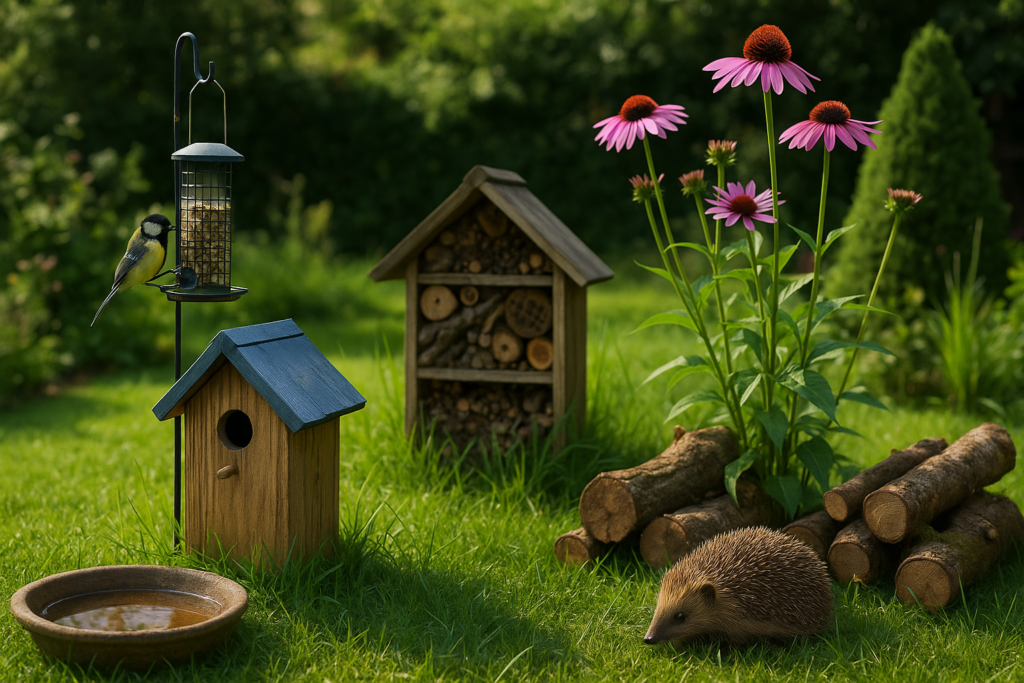Creating a wildlife-friendly garden is more than just a landscaping choice—it’s a commitment to biodiversity, sustainability, and the beauty of nature. By designing outdoor spaces that support birds, pollinators, and small mammals, Bright View Landscape transforms ordinary yards into thriving ecosystems. These designs go beyond visual appeal, creating functional habitats that benefit both wildlife and homeowners.
Why Support Local Wildlife in Your Landscape?
A well-planned landscape not only boosts curb appeal but also provides essential resources such as food, water, and shelter for native species. With urbanization and habitat loss threatening biodiversity, your garden can serve as a safe haven for local wildlife. The Bright View Landscape approach integrates native plants, eco-friendly water features, and habitat-building strategies to keep your yard vibrant year-round.
For clients who want transparency in every step of their project, our guide Is Bright View Landscape Transparent About Its Service Pricing explains our customer-first philosophy.
Understanding Wildlife Needs
1. Food Sources
Providing diverse and natural food sources is critical for attracting a variety of species. Native plants, fruit-bearing shrubs, and seed-rich flowers give wildlife the nutrients they need. Bird feeders with quality seeds and suet offer supplemental feeding, especially in winter.
Adding water features such as ponds or bird baths creates a dynamic feeding zone where insects, amphibians, and birds coexist, forming a balanced ecosystem.
2. Shelter and Nesting Sites
Safe nesting areas protect wildlife from predators and harsh weather. The Bright View Landscape design plan often includes:
- Birdhouses for different species
- Dense shrubs and native hedges
- Hedgehog houses and insect hotels
These elements double as aesthetic focal points while serving a functional ecological role.
3. Water Sources
Fresh, accessible water is essential year-round. Small ponds, shallow dishes, and strategically placed bird baths help wildlife stay hydrated. In winter, heaters or regularly refreshed water prevent freezing, ensuring animals can survive through harsh conditions.
Choosing the Right Plants
Native Plants
Native plants thrive in local climates and soil, making them low-maintenance and resilient. They provide food and shelter for native species, ensuring your landscape supports the local ecosystem.
Pollinator-Friendly Plants
To attract bees, butterflies, and hummingbirds, Bright View Landscape incorporates blooms like:
- Lavender
- Milkweed
- Coneflowers
- Salvia
These plants extend the flowering season, ensuring pollinators have food from early spring to late autumn.
Fruit-Bearing Plants
Shrubs and trees like holly, elderberry, and serviceberry provide food long after flowering season, sustaining birds and small mammals through winter.
Creating Diverse Habitats
A wildlife-friendly garden should mimic natural habitats. Bright View Landscape uses:
- Woodland Areas – Layered plantings of canopy trees, understory shrubs, and ground cover create shelter for multiple species.
- Water Features – Ponds, small streams, and bird baths become hubs of activity.
- Rock Gardens & Log Piles – Perfect for amphibians, reptiles, and beneficial insects.
Our design process can even incorporate sustainable hardscape features such as a stone bench or water fountain, enhanced by techniques in Granite Countertop Installation for durability and beauty.
Wildlife-Friendly Features to Add
- Bird Feeders & Houses – For year-round feeding and nesting
- Hedgehog Shelters – Safe havens during winter hibernation
- Insect Hotels – Crucial for pollination and natural pest control
- Log Piles & Leaf Litter – Simple yet effective shelters for small creatures
These features can be integrated into landscapes without compromising on style, aligning with Bright View Landscape with Eco-Friendly Lawn Practices.
Seasonal Tips for a Wildlife-Supporting Landscape
Spring
- Plant early-blooming flowers to feed pollinators
- Clean and refill water sources
- Install nesting boxes before breeding season
Summer
- Maintain regular watering, especially during heatwaves
- Keep feeders clean and stocked
- Refresh mulch to retain soil moisture
Autumn
- Plant late-blooming species for pre-winter nourishment
- Build leaf piles for overwintering insects and small mammals
- Clean out birdhouses before winter
Winter
- Provide high-energy foods like suet and seeds
- Ensure water sources are unfrozen
- Avoid heavy pruning to preserve natural shelters
Eco-Friendly Design and Functionality
Bright View Landscape integrates wildlife-friendly principles with sustainable hardscaping, rainwater harvesting, and modern garden features. From Insulating Glass Unit Guide for Architects and Builders for energy-efficient outdoor structures to the use of efficient tools like a jib crane for installing heavy garden elements, every detail is executed with precision and environmental care.
Final Thoughts
Supporting local wildlife through intentional landscaping isn’t just an environmental choice—it’s a lifestyle. Bright View Landscape ensures every design blends beauty, sustainability, and functionality, creating a living space that’s as good for nature as it is for homeowners.
For more inspiration on eco-friendly outdoor design, check out Bright View Landscape | Eco-Friendly Designs for Modern Yard and start planning your own wildlife-friendly retreat today.

